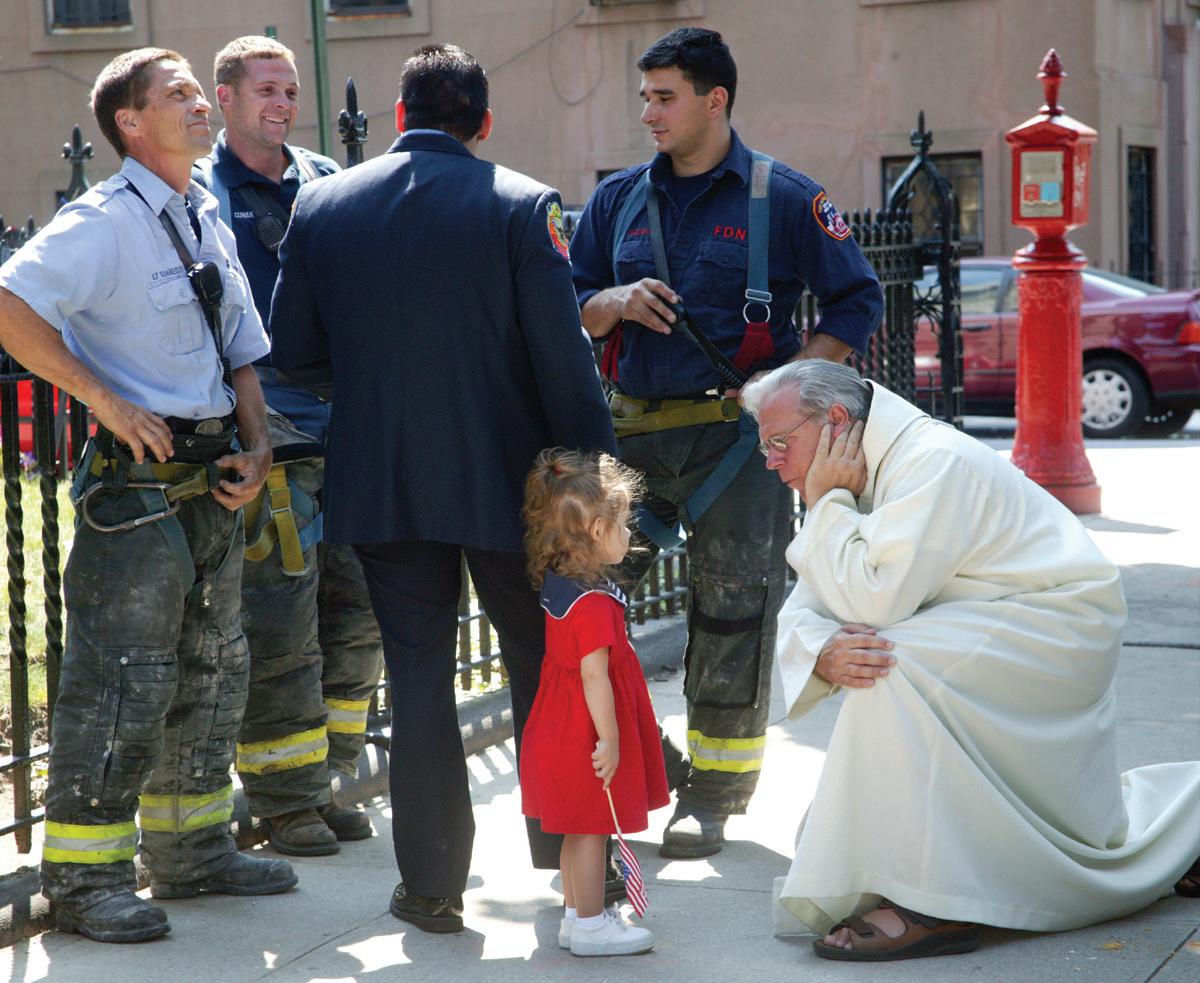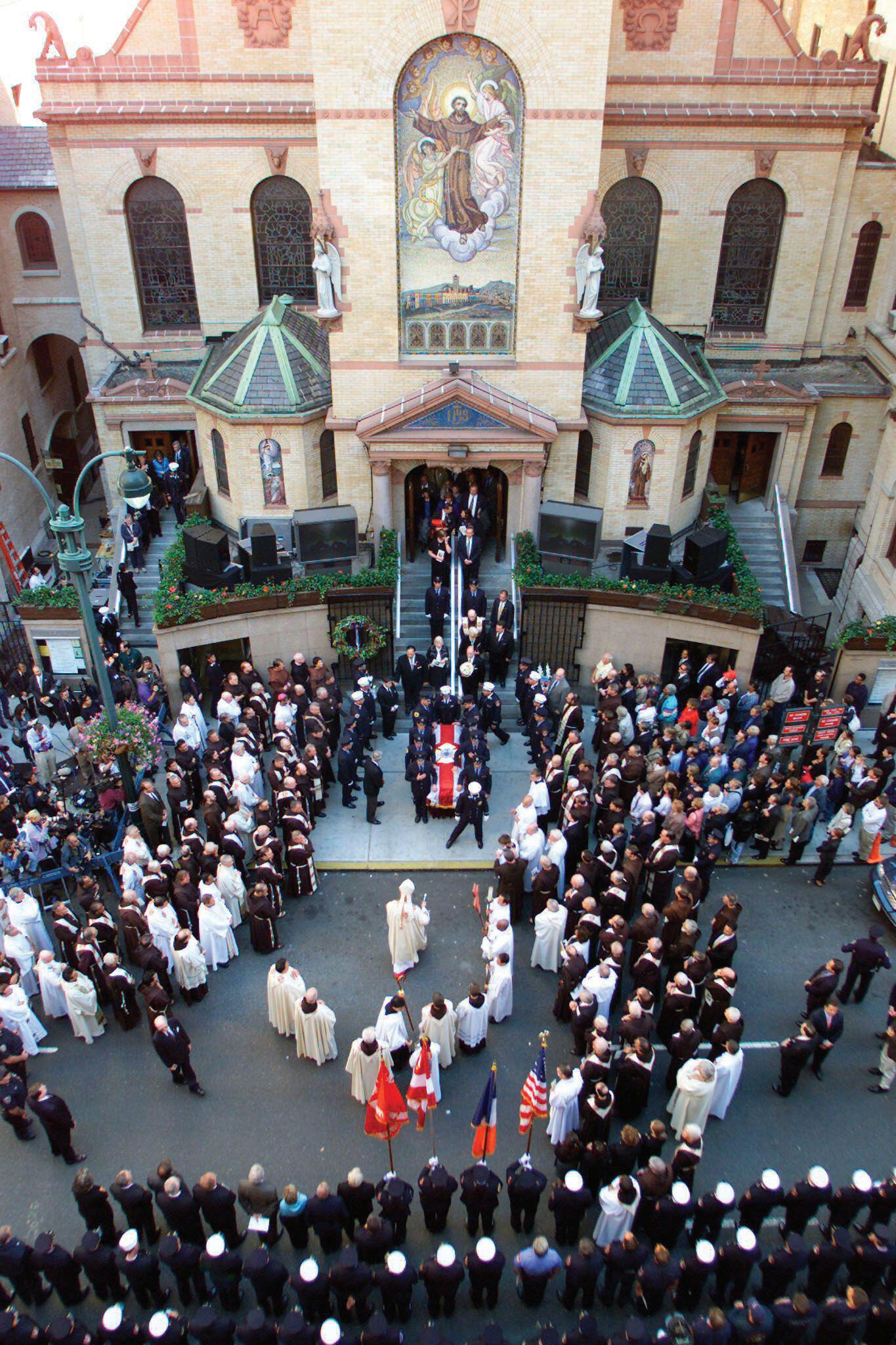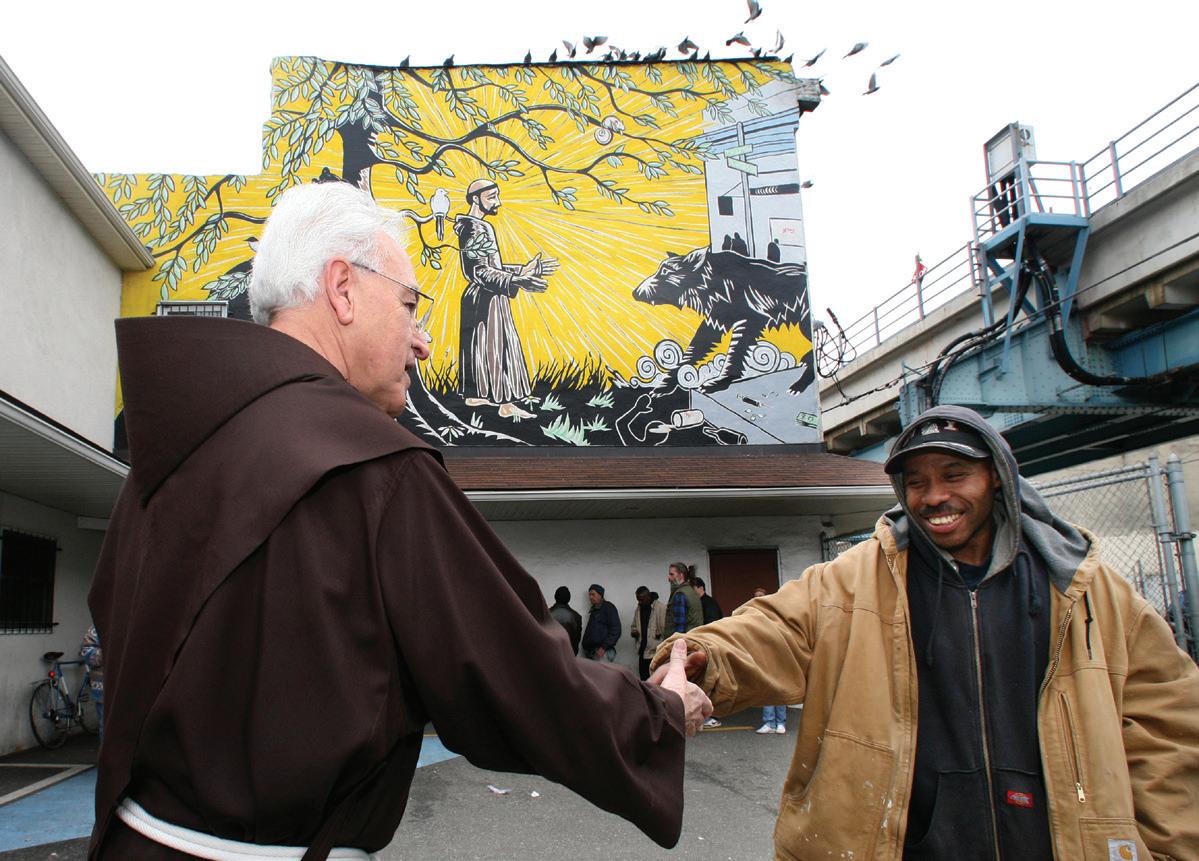
15 minute read
9/11 at 20: A Tale of Two Friars
Two Franciscans look back on their experiences of that day and its ongoing impact on their lives.
Ministries come in many forms—preaching, teaching, service, and others. For Franciscans, the goal of those ministries is always the same, though, and that is to be living witnesses of the Gospel to others. Sometimes, that witness plays out in a very public way. That was the case on September 11, 2001. On that day, the Twin Towers of the World Trade Center in New York City were struck by two hijacked commercial airplanes. The Pentagon in Arlington, Virginia, was struck, and another airplane crashed in Shanksville, Pennsylvania, after being hijacked.
Advertisement
Franciscan Father Mychal Judge is listed as victim number one of the 9/11 attacks in New York City. A fire chaplain for the city’s firefighters, Father Mychal was on the scene of the attack and praying for those who were jumping from the building when the first tower collapsed. The force of the collapse threw him backward across the lobby into the escalators. He died of blunt force trauma to his head. The photo of him being carried from the rubble has become a haunting icon of that day.
Franciscan Fathers Chris Keenan and Michael Duffy were both friends of Father Mychal. Through his death, they were called to minister, each in his own way, both during a very difficult time in our country’s history and still today.
These are their stories.
FATHER CHRIS KEENAN: A MINISTRY OF PRESENCE
For many of us, 9/11 is an event that took place in the past. But for Father Chris Keenan, OFM, it is not only history but also very much a part of the present. Father Chris is a chaplain for the New York City Fire Department (FDNY), where he ministers to the current firefighters, as well as those who still carry the scars of 9/11.
Twenty years ago, after the planes hit the World Trade Center, Father Chris immediately wondered how he could help. He made his way to St. Vincent’s Hospital, which was within half a mile of the site, and offered his assistance.
“I was there helping people in the emergency room once they were treated to connect with their families, letting them know that they were alive, and find ways to pick them up and get them home,” he says.
Late in the afternoon, when things started to slow down, Father Chris decided to head back to the friary because he was scheduled to hear confessions that evening at St. Francis of Assisi Church. He recalls, “As I came out of the hospital, there is this sea of hundreds of medical personnel with stretchers waiting for all the people who never came [out of the towers].”
On his way home, he stopped at the fire station across the street from St. Francis of Assisi Friary and Church and

Father Chris Keenan (far left) stands with the firefighters from Engine 1 Ladder 24 in honor and remembrance of those who died at the World Trade Center.

asked if they had any news about Father Mychal. It was then that Father Chris learned his friend and mentor had died. The firefighters told him that Father Mychal’s body was in the back of the firehouse.
“They had draped it in white, and his body was there in a bag,” remembers Father Chris. “I just stayed with him for about an hour. Then the rest of the friars came across the street, and we, with the firefighters, said a prayer. We friars said a blessing of St. Francis, and [Mychal’s] body was put in the ambulance and brought to the morgue.”
Immediately, Father Chris began ministering to the firefighters who had returned to the station and the families in search of loved ones who were firefighters. The gravity of the situation quickly became apparent. Within 48 hours, rescue and recovery turned to just recovery.
“Everyone and everything was vaporized, pulverized, and cremated,” says Father Chris.
MOVING FORWARD
Shortly after that day, Father Chris was appointed as a chaplain for the FDNY. It was not lost on him that he was stepping into some very big shoes. Mychal Judge had been a major influence in Father Chris’ life since he was 20 years old. He says that it was Father Mychal who influenced him to join the Franciscans. The two lived together at St. Francis of Assisi Friary.
As Father Chris says: “He got me in the business, and now he’s given me the business. When we’re commissioned in the fire department, we say, ‘I offer my life to protect the life and

Father Chris holds his FDNY chaplain jacket and helmet inside the chapel on the campus of the College of Mount St. Vincent. He currently lives on campus among the students—some of whose parents died on 9/11.
property of the people of New York City.’ So this isn’t just a job. It’s a calling.”
“For the next nine months, we had 343 funerals or memorials,” says Father Chris. Most of them were memorials because nothing was found. When remains were recovered and identified, the memorials would turn to funerals.
For seven months after the attacks, Father Chris took part in the recovery process on the pile two or three times a week. Rescue workers would rake the dirt looking for remains. “We would rake about the size of a basketball court. I said to them, ‘What am I looking for?’ and they said, ‘Don’t worry, Father, you’ll smell it.’”
“Those nights I would be there, it’s like, ‘How does one make sense of this?’ and I had the grace of an insight. As I was going down the bridge this one night I said, ‘I am descending into hell, and the face of God is on every one of those workers there in the recovery operation.’”
Along with Friar Brian Jordan, he celebrated Mass every week at the Ground Zero cross, a piece of steel that jutted out of the debris in the form of a cross and was kept as a symbol of hope. Little did he know, though, that those acts would greatly affect his life.
ONGOING MINISTRY
There were 343 families to relate to, both then and now, 20 years later. Those families included spouses, parents, over 800 children—some not even born yet—brothers, sisters, and other relatives. One of the connecting points he says that he has with the families is that he also had someone who died on 9/11.
The tragedy we’re still dealing with, points out Father Chris, is that in the years since 9/11, 250 more rescue workers have died, victims of the toxic brew of chemicals they worked in over the months at Ground Zero.
“I myself have five certified Trade Center conditions from my time of digging in the pit—cancer, esophagus, lungs, PTSD, sleep apnea. There are over 1,700 being treated for cancer in the FDNY alone.”
As the equipment would pull rubble off the pile, plumes of smoke would rise into the sky from the fires still burning underneath. Within that smoke was a toxic mixture of chemicals that had never been combined before. Because of that, Father Chris says, “There are 24 different toxic chemicals that they test our lungs for.”
When asked how he has sustained himself over the years, he is quick to praise his Franciscan brothers. “I really couldn’t have done this if I hadn’t been truly loved and supported by them in this effort. The other reality is that it was so wonderfully energizing working with and being with all of these wonderful people who offered the gift of their life to be there for others in their need.” He also credits spiritual direction and weekly therapy with helping him.
Father Chris will be retiring in January after 20 years on the job. And while he says that for most of the time he has been energized by his work as chaplain, the fire in his belly is beginning to die out. He says it is now time for another friar to be the next FDNY chaplain.
Now, two decades later, Father Chris says we need to keep the stories of 9/11 alive. For the past 10 years, he has lived in the dorms with students at the College of Mt. St. Vincent, where several of the children of 9/11 victims go to school. It’s a Franciscan fraternity of presence among the students.
For many of those students, 9/11 is something in the past. But Father Chris knows that’s only partly true. That is why he says: “They need to hear the stories of other people who have experienced 9/11 because those who fail to understand history will repeat it again. The greatest gift we have to give to one another is sharing our stories.”

”[Father Mychal Judge] loved to bring Christ to people. He was the bridge between people and God, and he loved to do that.”
—Father Michael Duffy
FATHER MICHAEL DUFFY: A MINISTRY OF PREACHING
Father Michael Duffy, OFM, remembers that it was a nice, bright, sunny day when he and a fellow friar headed out on September 11, 2001, to pick up leftovers from a supermarket for St. Francis Inn in Kensington, Philadelphia.
While driving, he heard the news on the radio that a plane had hit one of the World Trade Center towers. He wasn’t overly alarmed, he says, because he assumed it was a small plane. As the radio became more descriptive of the scene, though, he began to realize the enormity of the situation.
At 4:30 p.m. a fellow friar called him and said, “Mychal Judge is dead.” That, Father Michael says, “is when it just hit me. It did cross my mind that, ‘I bet [Mychal Judge] is down there doing something.’ But not that he would die.” He sat down on the stairs and cried.
The two friars were longtime friends. They met in the 1970s, when they were assigned to the same parish in East Rutherford, New Jersey. Eventually, Father Michael went to work in Philadelphia. Father Mychal went back to New York.
The friends often traveled together, and Father Michael recalls that their trips were often impromptu. They were also often delayed, he adds, due to situations where Father Mychal felt he needed to provide help, such as accidents they would come upon while driving.
A SHOCKING REQUEST
Given that friendship, it probably shouldn’t have been a surprise when Father Michael received a call the day after the attacks from his provincial minister at the time, Father John Felice.
“Mychal Judge had you down as his homilist,” said Father John. Franciscans are required to fill out forms stating their funeral wishes—the church, the readings, the music, the homilist, etc.
Father Michael says his immediate reaction was: “I can’t do this. This is a world event. I told him: ‘John, you’re the provincial; you should do it. It’s an important thing.’ And he said, ‘But he wanted you.’ So what are you going to say to that?”
There was also another challenge to the request, says Father Michael: Public speaking is one of his greatest fears. In fact, he says, “I almost did not become ordained because I’m terrified of speaking in front of people.” Now he was being asked to preach in front of a church full of people about his friend, whom he had just lost in a horrible attack on our nation.
“Everyone in the world was stunned. No one knew what to make of it. We were still watching the skies for more planes to do things. No one could explain how something like that could happen. And I was supposed to go up and say something significant? The second thing is, ‘What do you say? What do you say to make sense of all that?’”
ALAMY STOCK PHOTO/REUTERS/KEVIN COOMBS On the day of Father Mychal Judge’s funeral, crowds not only filled St. Francis of Assisi Church in Midtown Manhattan, but also the surrounding streets outside the church. The funeral was televised throughout the world. It is estimated that over 81 million people watched the funeral.


Father Michael Duffy greets a guest at St. Francis Inn in Kensington, Philadelphia. The ministry has served meals to people in need since 1979.

Father Michael sits with a young visitor at St. Francis Inn as he enjoys a cupcake. Volunteers at the ministry serve over 350 meals a day.
Those three days between the event and the funeral, he says, were some of the toughest of his life. He says he wasn’t even able to focus on the fact that he had just lost his best friend.

PREACHING FROM THE HEART
On the day of the funeral, when it came time to deliver the homily, Father Michael reached for his glasses only to discover he couldn’t get to them inside his habit. He was going to have to preach from memory. And he went on to speak to the spirit and goodness of his friend rather than against the situation that caused his death.
“Mychal Judge’s body was the first one released from Ground Zero. His death certificate has the number one on the top. I meditated on that fact of the thousands of people that we are going to find out who perished in that terrible holocaust. Why was Mychal Judge number one? And I think I know the reason. Mychal’s goal and purpose in life at that time was to bring the firemen to the point of death, so they would be ready to meet their maker,” Father Michael said.
“Mychal Judge could not have ministered to them all. It was physically impossible in this life but not in the next. And I think that if he were given this choice, he would prefer to have happened what actually happened. He passed through the other side of life, and now he can continue doing what he wanted to do with all his heart. And the next few weeks, we’re going to have names added, name after name of people who are being brought out of that rubble. And Mychal Judge is going to be on the other side of death to greet them instead of sending them there. And he’s going to greet them with that big Irish smile. He’s going to take them by the arm and the hand and say, ‘Welcome, I want to take you to my Father.’ And so, he can continue doing in death what he couldn’t do in life.”
After the Mass, Father Michael says he came to learn that with the people in the church—both upstairs and downstairs—the overflow crowd on the street outside, and the broadcast on all the major news networks, 81 million people around the world saw him preach.
“Someone later said, ‘Do you realize you, as a Franciscan, preached to more people than St. Francis did?’” he remembers.
Since that day 20 years ago, Father Michael has tried not to look back too much. He hasn’t visited the 9/11 memorial and says he has no plans to go. At one time, he received a painting of the poignant picture of a fireman, police officer, Port Authority officer, and layman carrying Mychal Judge’s lifeless body out of the rubble. Some refer to it as a modern-day pietà. But he donated it to a firehouse in Maryland.
“Who in the world would want to wake up every morning and see a picture of their best friend dead?” he asks.
And though he misses his friend, Father Michael says he finds solace in the faith they shared. “The thing is, he had so much faith. And, hopefully, I do too. To me it was just, ‘Oh, I won’t see you for a little while, but I’ll see you later.’ And I really believe that.” Still, he says: “I can’t wait to see him. I’m going to kill him for putting my name down on that paper.”
5/11/1933 • 9/11/2001
—Mychal Judge, OFM

PRIOR TO 9/11, not many people knew Father Mychal Judge outside of New York City. But inside the city, he was quite the presence. And while he is most noted for his role as a chaplain of the fi re department for almost 10 years, his ministries expanded well beyond.
Over the years, he was known for his daily interactions with people, offering a blessing, sending a note, or just listening. He ministered to the homeless, recovering alcoholics—of which he was one—and those suffering from AIDS, visiting them when many priests would not. It was all those interactions that made him such a powerful presence to many, say those who knew him.
“Everyone thought he was their best friend,” says Father Michael Duffy.

Susan Hines-Brigger is an executive editor of this magazine. Father Mychal Judge’s twin sister, Dympna, looks on as Father Chris Keenan (at podium) and fi refi ghters remember her brother. Father Mychal’s jacket and helmet (on display) were found intact in the rubble six months after the attack.



TOP AND MIDDLE: BROTHER OCTAVIO DURAN;, OFM; LOWER LEFT: COURTESY OF HOUSE OF WATERFORD CRYSTAL; LOWER RIGHT: FATHER CHRIS KEENAN ARCHIVES This Waterford Crystal piece, sculpted by Sean Egan, depicts the iconic image of Father Mychal Judge’s body being carried from the rubble on 9/11. The piece was designed to honor not only Father Mychal but also the 342 other FDNY members who died that day. In this photo from the 1970s, Father Mychal Judge (top left) stands with a group of fellow friars, including Father Chris Keenan (next to Father Mychal) and Father Michael Duffy (second row, right).










